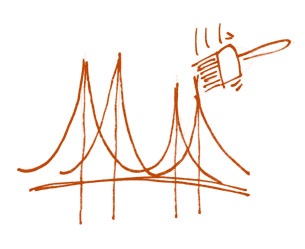A Coaching Model Created by Hector Sandoval
(Leadership Coach, SPAIN)
Introduction:
Leadership, among many possible definitions, can be understood as a collection of special attributes and skills associated with exceptional individuals. It is in our nature to admire and follow leaders. In some dimensions of our lives we tend to emulate their actions and, in particularly difficult or challenging situations, we tend to rely on strong leaders to set the course and inspire us.
When, as individuals, we feel that there is something to be changed, improved or transformed in our lives, we may also expect someone to show us how, to ‘lead the way’. However, linking the need to change to an external source can also result in apathy, delays, and an overall static position. When change doesn’t occur as desired we blame someone or something else, and in some cases we end up worse than the original starting point.
In this context the LeadER Model is a simple but effective call to action based on the premise that each and every one of us can identify, adopt and excel at essential leadership skills to undertake the desired change. It is also a process that supports improvement and the pursuit of a higher degree of satisfaction in our professional and personal dimensions. Adopting leadership skills should be a natural ability to take an empowered and effective attitude, so long as we are willing to put the effort and commitment. Leadership, in a general sense, is no longer reserved only to a privileged few.
Developing a Model:
In its essence Coaching is a dynamic relationship that aims to support a Client’s intention to act and move towards a more empowered and fulfilling state, and can be explained in simple terms:
As a visual reference Coaching, and the LeadER Model included, can be viewed as a Bridge:
A Model for Executive Coaching:
One of the main characteristics of coaching Clients in senior leadership and management positions is the need for a strong ‘contracting’ process in the beginning of the relationship. This becomes more relevant as the Coach will usually enter into a three-party relationship that includes the Client as well as a ‘Sponsor’ (a corporate representative from the HR function or the Client’s supervisor).
Some Coaches feel that additional parties should be included in the initial contracting: stakeholders such as the Client’s peers and direct reports, and maybe other individuals that routinely interact with the individual. At any rate, before a specific, tailored model can be put in place between the Client and Coach, significant effort should be dedicated in this initial phase in order to establish:
The LeadER Model:
With all the above secured, documented and signed-off, the Coaching relationship begins. The steps of the model can be outlined in different themes. Each theme is open enough to incorporate a wide variety of tools, techniques and processes around the following areas:
 Listening:
Listening:
A crucial pillar that supports the entire foundation. The role of the Coach is to listen with attention, curiosity and undivided focus to clearly understand the Client’s story.
Listening also supports the creation of a safe and trusted space where the Coaching Conversation flows from the original state of being to the desired outcome expressed by the Client.
Powerful questions complement the listening skills in order to solicit information and stimulate reflection.
Learning:
An effective Coaching engagement will lead the Client to learn and develop self-awareness and a better understanding of what enables or prevents change from taking place.
Leveraging:
As the Client relates, explains, and learns, valuable skills and strengths are leveraged to support the vision and plans that lead to a state of change and growth.
Evaluating:
During the development of the Coaching process different tools and assessments can be incorporated to evaluate different aspects, validating and discussing relevant information with the Client and their intention.
Energizing:
A successful Coaching conversation should promote and sustain positive energy levels in order to fuel the actions and the efforts required to undertake change.
Escalating:
Depending on the initial needs and expectations, the process may lead to more critical actions being escalated or prioritized in order to optimize efforts and results.
Action Planning:
One of the core elements of the model is the design and implementation of actions. Plans should include goals, structures to achieve them, strategies, time frames, and measures of success. Plans also include contingencies and risk management elements.
Deciding and Delivering:
Change occurs when the Client decides to embrace it, and is willing to deliver on the vision and plans.
The ‘ER’ in the Lead:
Many new plans and ideas generate enthusiasm and positive energy, but can fail or under-deliver because of the lack of Execution and Review. These are critical aspects of the LeadER Model translated into the commitment to act, the accountability between Coach and Client to the change actions, and continued revisions and reframing as needed in order to achieve the ultimate goals.
Conclusions:
a) The LeadER Model, as with any Coaching Model, should be flexible enough to adapt to the Client’s requirements but yet provide a general structure that ensures the essential coaching experience is attained: discovery, awareness and perspective reframing, action and commitment towards change, accountability, celebration of success and review of the wins to sustain a new state of being.
b) In the LeadER Model, the Client determines the agenda, the rhythm, the outcome, but the Coach is responsible for managing the process and ensuring that the journey’s definition of origin, transition and destination are present and available for reference.
c) A Model that is too rigid cannot take advantage of the many tools and techniques offered in modern Coaching. The LeadER Model, while proving a general structure and some critical checkpoints to maintain the Client’s agenda on track, is open enough to contemplate activities such as: visualization, role playing, storytelling, among others.
d) A Leader is someone who sets a course, a vision. Someone who is capable of inspiring, motivating and identifying the best capabilities among a team, individually and collectively. A Leader is accountable for results, sharing the success and assuming responsibility during setbacks. A Leader is accessible, honest, and is prepared to consider alternatives and options suggested by others.
In this context, the LeadER Model provides a structure where anyone who is willing to commit to change, improvement and increased effectiveness, can adopt these traits and incorporate them into their lifestyle.


